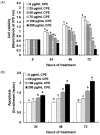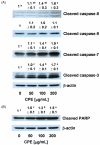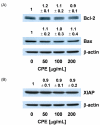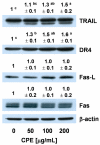Chestnut extract induces apoptosis in AGS human gastric cancer cells
- PMID: 21779520
- PMCID: PMC3133749
- DOI: 10.4162/nrp.2011.5.3.185
Chestnut extract induces apoptosis in AGS human gastric cancer cells
Abstract
In Korea, chestnut production is increasing each year, but consumption is far below production. We investigated the effect of chestnut extracts on antioxidant activity and anticancer effects. Ethanol extracts of raw chestnut (RCE) or chestnut powder (CPE) had dose-dependent superoxide scavenging activity. Viable numbers of MDA-MD-231 human breast cancer cells, DU145 human prostate cancer cells, and AGS human gastric cancer cells decreased by 18, 31, and 69%, respectively, following treatment with 200 µg/mL CPE for 24 hr. CPE at various concentrations (0-200 µg/mL) markedly decreased AGS cell viability and increased apoptotic cell death dose and time dependently. CPE increased the levels of cleaved caspase-8, -7, -3, and poly (ADP-ribose) polymerase in a dose-dependent manner but not cleaved caspase-9. CPE exerted no effects on Bcl-2 and Bax levels. The level of X-linked inhibitor of apoptosis protein decreased within a narrow range following CPE treatment. The levels of Trail, DR4, and Fas-L increased dose-dependently in CPE-treated AGS cells. These results show that CPE decreases growth and induces apoptosis in AGS gastric cancer cells and that activation of the death receptor pathway contributes to CPE-induced apoptosis in AGS cells. In conclusion, CPE had more of an effect on gastric cancer cells than breast or prostate cancer cells, suggesting that chestnuts would have a positive effect against gastric cancer.
Keywords: Chestnut; anticancer effect; antioxidant activity; ethanol extracts of chestnut; gastric cancer.
Figures





Similar articles
-
Poncirin Induces Apoptosis in AGS Human Gastric Cancer Cells through Extrinsic Apoptotic Pathway by up-Regulation of Fas Ligand.Int J Mol Sci. 2015 Sep 18;16(9):22676-91. doi: 10.3390/ijms160922676. Int J Mol Sci. 2015. PMID: 26393583 Free PMC article.
-
Induction of apoptosis and G1 phase cell cycle arrest by Aster incisus in AGS gastric adenocarcinoma cells.Int J Oncol. 2018 Nov;53(5):2300-2308. doi: 10.3892/ijo.2018.4547. Epub 2018 Aug 30. Int J Oncol. 2018. PMID: 30226597
-
Association of a Methanol Extract of Rheum undulatum L. Mediated Cell Death in AGS Cells with an Intrinsic Apoptotic Pathway.J Pharmacopuncture. 2015 Jun;18(2):26-32. doi: 10.3831/KPI.2015.18.012. J Pharmacopuncture. 2015. PMID: 26120485 Free PMC article.
-
Ethanol extract of paeonia suffruticosa Andrews (PSE) induced AGS human gastric cancer cell apoptosis via fas-dependent apoptosis and MDM2-p53 pathways.J Biomed Sci. 2012 Sep 10;19(1):82. doi: 10.1186/1423-0127-19-82. J Biomed Sci. 2012. PMID: 22963678 Free PMC article.
-
Tangeretin, a citrus polymethoxyflavonoid, induces apoptosis of human gastric cancer AGS cells through extrinsic and intrinsic signaling pathways.Oncol Rep. 2014 Apr;31(4):1788-94. doi: 10.3892/or.2014.3034. Epub 2014 Feb 19. Oncol Rep. 2014. PMID: 24573532
Cited by
-
Radish (Raphanus sativus L. leaf) ethanol extract inhibits protein and mRNA expression of ErbB(2) and ErbB(3) in MDA-MB-231 human breast cancer cells.Nutr Res Pract. 2011 Aug;5(4):288-93. doi: 10.4162/nrp.2011.5.4.288. Epub 2011 Aug 31. Nutr Res Pract. 2011. PMID: 21994522 Free PMC article.
-
Suppression of Nrf2 Activity by Chestnut Leaf Extract Increases Chemosensitivity of Breast Cancer Stem Cells to Paclitaxel.Nutrients. 2017 Jul 18;9(7):760. doi: 10.3390/nu9070760. Nutrients. 2017. PMID: 28718813 Free PMC article.
-
Benzyl Isothiocyanate Induces Apoptosis via Reactive Oxygen Species-Initiated Mitochondrial Dysfunction and DR4 and DR5 Death Receptor Activation in Gastric Adenocarcinoma Cells.Biomolecules. 2019 Dec 6;9(12):839. doi: 10.3390/biom9120839. Biomolecules. 2019. PMID: 31817791 Free PMC article.
-
Potential Anticancer Effects of Polyphenols from Chestnut Shell Extracts: Modulation of Cell Growth, and Cytokinomic and Metabolomic Profiles.Molecules. 2016 Oct 21;21(10):1411. doi: 10.3390/molecules21101411. Molecules. 2016. PMID: 27775667 Free PMC article.
References
-
- Paillet FL. Chestnut: history and ecology of a transformed species. J Biogeogr. 2002;29:1517–1530.
-
- Kim JS, Jung BH, Joo RW, Choi SI. Marketing of chestnut and economic analysis of chestnut cultivation. Korean J For Econ. 2004;12:12–21.
-
- Heo J. Doguibogam. Seoul: Hanmibook press; 2001. p. 1153.
-
- Vekiari SA, Gordon MH, García-Macías P, Labrinea H. Extraction and determination of ellagic acid content in chestnut bark and fruit. Food Chem. 2008;110:1007–1011. - PubMed
-
- Barreira JCM, Ferreira ICFR, Oliveira MBPP, Pereira JA. Antioxidant activities of the extracts from chestnut flower, leaf, skins and fruit. Food Chem. 2008;107:1106–1113.
LinkOut - more resources
Full Text Sources
Research Materials
Miscellaneous

